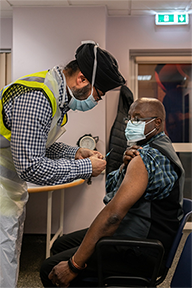- Home
- About Us
- Membership
- Partners
- Resources
- Education & Events
- Advocacy
- Advocacy Letters
- COVID-19
- Shared Savings Program
- Medicaid ACOs
- CMMI Models
- ACO Program Elements
- Quality and Equity
- Congress
- Payment Rules
- Other Regulations
- News
- ACO News
- NAACOS Blog
- NAACOS In the News
- NAACOS Member News
- Press Releases & Letters
2022 NAACOS Leaders in Quality Excellence AwardsAbout the AwardThe NAACOS Leaders in Quality Excellence Awards was established in 2021 to recognize ACOs working to improve the quality and safety of patient care and advance population health goals. Following an open call for nominations, the NAACOS Quality Committee selected the top three submissions to showcase the quality improvement efforts undertaken by NAACOS members and to disseminate best practices among ACOs. The 2022 award winners include St Joseph’s Health ACO, UNC Health Alliance, and Summit Health. These ACOs exemplify how ACOs across the country are improving care by closing care gaps, addressing disparities in care, and improving care transitions. The following criteria were used to select the winners:
Awardee HighlightsUNC Health Alliance Focuses on Reducing Disparities The ACO used tools to target vulnerable populations with varying forms of outreach, including automated calls/texts, direct scheduling, mobile vaccine units, and partnering with community organizations. The ACO Leveraged the use of Race, Ethnicity and Language (REaL) data in conjunction with Social Vulnerability Index (SVI) data to identify and close disparities in quality, access, safety, and patient experience. Relying on weekly analysis, the ACO analyzed outreach tactics’ effectiveness to improve opportunities for the historically marginalized to access vaccinations. Pre and post intervention showed a significant increase in vulnerability demographics for those people being vaccinated in the community. This data was then made available in the electronic medical record (EMR) to support future, similar efforts. In partnership with other stakeholders, the ACO will continue to build upon the experience of COVID-19 to develop lasting community health interventions to benefit its patients. St. Joseph’s Health ACO Addresses Care Transitions The ACO also implemented a technology platform, Real Time, to support this effort. The Real Time platform evaluates over 300 clinical indicators to identify a patient’s readmissions risk. The nurse navigators used this data with the SNFs to educate and provide open dialogue about the patient’s care and follow-up needs. As a result of this project, the ACO was able to decrease readmissions from SNFs from 24 percent in 2019 to 15.9 percent in 2021. Additionally, the project resulted in more collaborative relationships with SNFs and high performing SNFs in particular, resulting in higher quality care for patients. This also allows for sharing of best practices between SNFs in the HPN, facilitated through monthly readmission and quarterly town hall meetings. Summit Health Closes Quality Measure Gaps Using AWVs As a result of the program AWV completion rates rose from 39 percent in 2017 to 72 percent in 2021. To sustain the program, Summit Health also developed a value-based care boot camp, AWVs being one of the seven, one-hour education sessions for new providers. AWVs were also offered via tele-visit or in combination with other comprehensive care visits, particularly important to sustaining AWV rates throughout the COVID-19 pandemic. The overall impact on quality was an 8 percent increase in quality measure gap closures and an 11 percent increase in continued alignment in patients as compared to those without AWVs. |

 This ACO was focused on reducing disparities in COVID-19 vaccination rates in the community, resulting in improvements in the vaccination rates for those with social vulnerabilities. UNC Health Alliance created the COVID-19 Vaccine Equity Reimagined for North Carolina (COVER NC) Program to address health equity for the patients served across the state of North Carolina. UNC Health, together with the UNC Health Alliance, aimed to create equity in opportunity for vaccination among those in rural, minority, and marginalized communities. A cross-functional team of clinicians and support personnel came together to lead an equitable population health response to COVID-19 vaccination. By engaging community leaders and organizations to deliver solutions that marginalized communities want and need, the ACO provided multi-modal access to vaccination designed to address specific barriers faced by marginalized groups in the community served. As an example, the ACO identified transportation needs and access to care close to home as critical to their success.
This ACO was focused on reducing disparities in COVID-19 vaccination rates in the community, resulting in improvements in the vaccination rates for those with social vulnerabilities. UNC Health Alliance created the COVID-19 Vaccine Equity Reimagined for North Carolina (COVER NC) Program to address health equity for the patients served across the state of North Carolina. UNC Health, together with the UNC Health Alliance, aimed to create equity in opportunity for vaccination among those in rural, minority, and marginalized communities. A cross-functional team of clinicians and support personnel came together to lead an equitable population health response to COVID-19 vaccination. By engaging community leaders and organizations to deliver solutions that marginalized communities want and need, the ACO provided multi-modal access to vaccination designed to address specific barriers faced by marginalized groups in the community served. As an example, the ACO identified transportation needs and access to care close to home as critical to their success.  The Mission Health Coordinated Care ACO of St. Joseph’s Health System was focused on quality improvement in the skilled nursing facility (SNF) setting. A post-acute care nurse navigator position was created to monitor patients at SNFs and collaboratively work with the SNFs on discharge dates, a patient’s progress, and assisting with the transition to the home setting. The goals of this program were to decrease readmissions of SNF patients and improve relationships and collaborations with SNF High Performing Networks (HPNs). As an example, patients were assisted with planning for transitions home, including arranging for a visiting nurse service with a SNF social worker, coordinating a follow-up visit with the patient’s primary care provider (PCP) within one week of discharge, and educating the patient on discharge instructions. This included ensuring that patients and their caregivers were provided with contacts for support services for post-acute care nurse navigators.
The Mission Health Coordinated Care ACO of St. Joseph’s Health System was focused on quality improvement in the skilled nursing facility (SNF) setting. A post-acute care nurse navigator position was created to monitor patients at SNFs and collaboratively work with the SNFs on discharge dates, a patient’s progress, and assisting with the transition to the home setting. The goals of this program were to decrease readmissions of SNF patients and improve relationships and collaborations with SNF High Performing Networks (HPNs). As an example, patients were assisted with planning for transitions home, including arranging for a visiting nurse service with a SNF social worker, coordinating a follow-up visit with the patient’s primary care provider (PCP) within one week of discharge, and educating the patient on discharge instructions. This included ensuring that patients and their caregivers were provided with contacts for support services for post-acute care nurse navigators. This ACO was focused on closing quality measure gaps for patients by improving completion of annual wellness visits (AWVs). AWVs are intended to prevent future health problems by checking a patient’s weight, blood pressure and other critical measurements, as well completing important screenings and referrals for any needed health services. Summit Health developed an AWV-focused program and implementation plan to educate, engage, and support stakeholders in the ACO, such as primary care providers, care teams, administrators and leadership, as well as support staff and patients about the value of completing an AWV. Working with these teams, the ACO followed a systemwide approach to support AWV completion, provider and patient engagement, and follow-up throughout the process. By closing care gaps using AWVs, Summit Health saw progressive improvement in preventive quality measure performance rates year over year. As an example, fall risk screenings increased from 77.7 percent in 2017 to 97.9 percent in 2020 and influenza vaccination rates rose from 78.5 percent in 2017 to 91.1 percent in 2020.
This ACO was focused on closing quality measure gaps for patients by improving completion of annual wellness visits (AWVs). AWVs are intended to prevent future health problems by checking a patient’s weight, blood pressure and other critical measurements, as well completing important screenings and referrals for any needed health services. Summit Health developed an AWV-focused program and implementation plan to educate, engage, and support stakeholders in the ACO, such as primary care providers, care teams, administrators and leadership, as well as support staff and patients about the value of completing an AWV. Working with these teams, the ACO followed a systemwide approach to support AWV completion, provider and patient engagement, and follow-up throughout the process. By closing care gaps using AWVs, Summit Health saw progressive improvement in preventive quality measure performance rates year over year. As an example, fall risk screenings increased from 77.7 percent in 2017 to 97.9 percent in 2020 and influenza vaccination rates rose from 78.5 percent in 2017 to 91.1 percent in 2020.